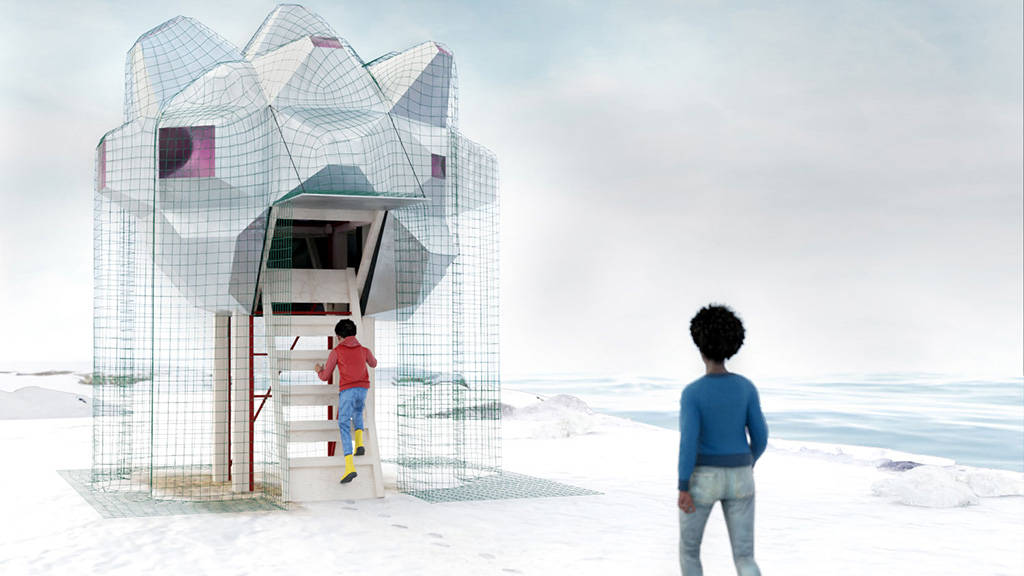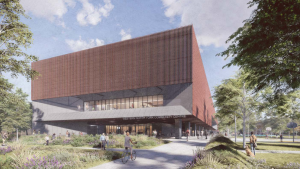TORONTO — The inspiration for the winners of this year’s Winter Stations came from a UFO, a kaleidoscope and previous installations.
The public exhibition will take place at Woodbine Beach in Toronto starting Feb. 19. The theme for 2024 is Resonance, a celebration of 10 years of Winter Stations.
The goal of the international design competition is to bring people to the beach in the winter months. The lifeguard structures are used as visual anchor points for the installations.
We Caught A UFO! by Xavier Madden and Katja Banović (Croatia and Australia) builds upon the project In the Belly of a Bear, which utilized the lifeguard chair by lifting the public above ground into a cozy space and transporting them into a new world, the Winter Stations website states.
The installation references rumours of the many UFO sightings across Lake Ontario.
The UFO is caught under a net and wrapped in glued aluminum foil which glimmers in the light, contrasting its surroundings as a foreign object. The public can explore the structure and climb up into the main space where pink plexi windows transform the beach into a new tinted landscape or “planet.”
Resonating with OneCanada and WE[AR] projects, WINTERACTION is a dual installation in Iran and Canada. It fosters solidarity and social interaction between the two nations. Visitors are invited on an introspective journey through a labyrinth, symbolizing a complex and challenging quest, leading from confusion to enlightenment, to reach inner peace. At the centre, a virtual tree emerges as a symbol of peace and alliance. The installation was designed by the University of Guelph Department of Landscape Architecture and Ashari Architects (Canada and Iran).
![WINTERACTION, by the University of Guelph Department of Landscape Architecture and Ashari Architects is a dual installation in Iran and Canada and fosters solidarity and social interaction between the two nations. It resonates with OneCanada and WE[AR] projects.](https://cc-production-uploads-bucket.s3.amazonaws.com/uploads/2024/01/FRONT-DCN-AG-Winter-stations-10th-anniversary-Winteractionweb.jpg)
An adaptation of Kaleidoscope of the Senses, 2020, Kaleidoscopic Odyssey invites onlookers to step into an experience challenging where reality ends and imagination begins. There are two guiding concepts in the installation.
The scale of a traditional kaleidoscope is magnified 84 times to a humanscale so participants can inhabit the instrument. Where a kaleidoscope is commonly a closed-loop system, this device is deliberately severed into two sculptured equal-and-opposite parts, the website indicates.
The design is by Canadian firm Brander Architects Inc. The team consists of Adam Brander, Nilesh P, Ingrid Garcia and Maryam Emadzadeh.

Nimbus by David Stein (Canada) was inspired by the airy strands that make up the 2016 installation Floating Ropes. Nimbus evolves the concept and materials by adding saturated blue ropes hanging below a bubbly white structure. The station asks visitors to consider the presence and absence of rain in the world by referencing both severe storms and flooding as well as concerning trends of lack of rain, drought and desertification.
Making Waves, by Adria Maynard and Purvangi Patel of Canada, is described as “a whimsical piece of furniture that represents the ways that simple actions can ripple outwards to ‘resonate’ across time and space, moving and impacting others in surprising ways.”
The installation takes the form of an exaggerated couch and creates an unusual urban living room where neighbours can gather and sit together by the water.
The design was inspired by kinetic sculptures and whirligigs and is composed of a series of parts that dance when cranks are turned. Wooden slats act as rippling bench that rock and move and vertical poles tipped with glowing globes bob in the air to signal people from afar.
Bobbin’ by the University of Waterloo School of Architecture invites the visitor to a place where pivotal moments and whimsical memories prompt reflection. It shelters visitors with slats that create an ever-changing threshold between the bobbing zone and the surrounding beach. The seesaws draw from the playground-like Sling Swing and Lifeline projects, while its form within the landscape reflects HotBox and Introspection. The material was sourced from previous student projects in addition to salvaged materials from the community of Cambridge.
Designed by the Toronto Metropolitan University (TMU) Department of Architectural Science, Nova is a star that has crashed on top of a lifeguard station and illuminates Woodbine Beach throughout the night. Nova highlights TMU’s past decade of Winter Stations, inspired by the origami materiality and form of Snowcone, Lithoform, and S’Winter Station. Nova introduces 3D printing, a textile canopy and an elegant steel pipe connection, states the website, adding the star pavilion shields users and encourages them to engage with their surroundings and the lifeguard station serves as a beacon to access panoramic views of the beach.









Recent Comments